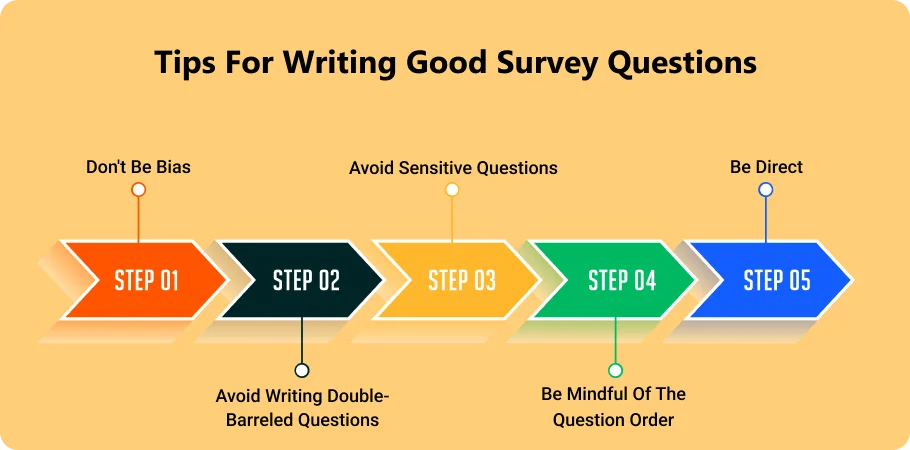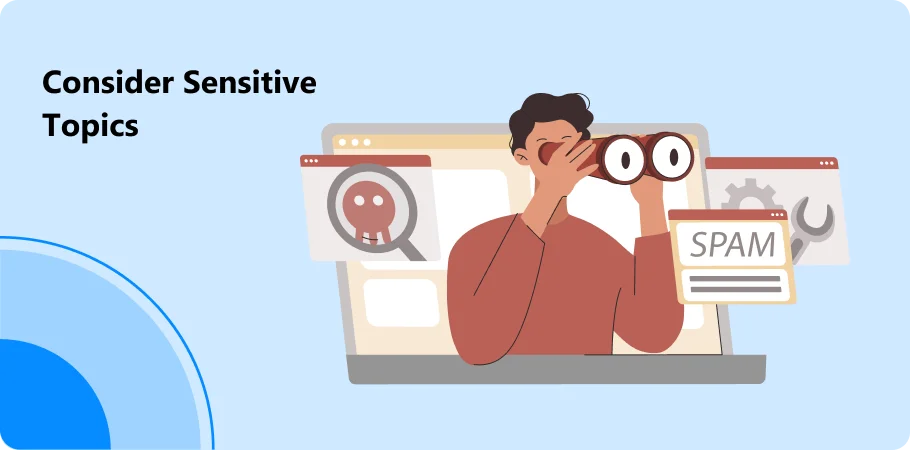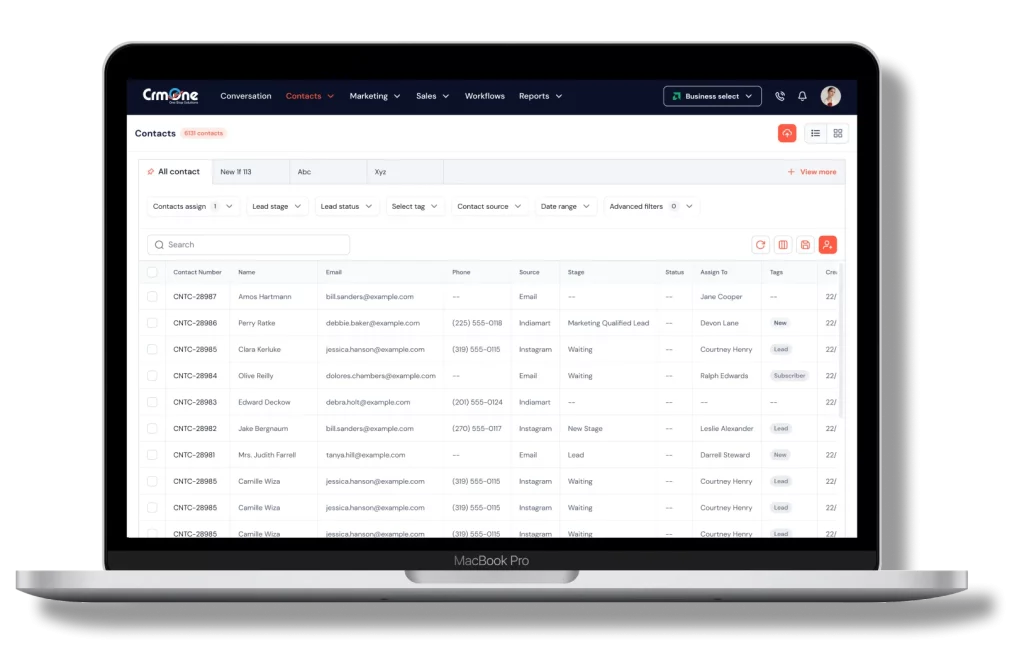In today’s data-driven landscape, surveys are invaluable tools for extracting meaningful insights from target audiences. However, a study’s efficacy hinges mainly on the quality of its questions. Crafting well-designed survey questions demands a delicate balance of considerations, including understanding the Core audience, delineating survey objectives, and selecting appropriate question formats.
In this comprehensive guide to survey creation in 2025, we’ll explore the nuances of writing good survey questions, catering to specific target audiences, utilizing survey templates, and optimizing online and web surveys for collecting quantitative data. By adhering to best practices and employing the provided tips and examples, you can initiate surveys that engage respondents and yield actionable insights for informed decision-making. Let’s delve into the intricacies of survey design and embark on the journey of gathering invaluable data.
Tips for Writing Good Survey Questions

Writing straightforward, unbiased, and engaging survey questions is essential for collecting reliable data. Here are some tips to help you craft practical survey questions:
1. Be Clear and Concise:
When creating survey questions, prioritize simplicity and clarity. Avoid using jargon or ambiguous terms that might confuse respondents. Use your own words to clearly and straightforwardly express each question. Ensure that every question stands alone and is easily understood without additional context. This approach is crucial for developing a good survey questionnaire that facilitates accurate responses and effectively utilizes rating scale questions.
Separating questions and employing a straightforward question format facilitates better comprehension and yields more accurate survey results. Clarity is critical to crafting the best surveys and obtaining valuable insights from your core audience.
2. Avoid Leading Questions:

When you write questions, you must be cautious of crafting leading questions that may inadvertently steer respondents toward a particular answer. Striving for neutrality is critical to preventing bias in your survey. Leading questions have the potential to influence respondents’ perceptions, leading to skewed data and inaccurate results. To maintain integrity in your survey, each question should neutrally present options or prompts, allowing respondents to answer freely based on their perspectives.
Avoiding leading questions creates a level playing field for all respondents, ensuring that the data collected accurately represents their genuine opinions. Writing good survey Queries requires carefully considering how each question may lead respondents to answer.
Take the time to craft questions that encourage a deep dive into respondents’ true sentiments without guiding their answers. This approach fosters an environment where respondents feel comfortable expressing their genuine thoughts and experiences.
3. Use Mutually Exclusive Answer Choices:

When crafting survey questions, it’s crucial to ensure that each answer option is distinct and does not overlap. This practice helps to avoid confusion among respondents and ensures clarity in their responses. Providing mutually exclusive answer choices is essential for obtaining accurate data, especially when dealing with potentially sensitive topics or using a rating scale query style.
By employing this strategy in market research and other research methods, you contribute to writing good survey Queries that facilitate clear and concise responses, particularly in scenarios where many respondents are involved.
Additionally, using mutually exclusive answer choices helps mitigate potential bias and ensures that respondents can freely express their genuine opinions without being influenced by leading questions. Start writing your survey Queries with this approach to encourage respondents to provide honest feedback on various topics.
4. Consider Question Order:

When constructing your survey, think carefully about the order of your questions. Arrange them logically, beginning with easy-to-answer demographic questions before delving into potentially delicate subjects or more complex topics. This approach helps to ease respondents into the survey and encourages participation. By starting with less challenging questions, you build rapport with your survey respondents and increase the likelihood of obtaining answers throughout the survey.
Additionally, organizing questions thoughtfully can lead to more applicable insights and higher data completeness. Avoid common mistakes such as mixing unrelated topics or placing sensitive questions too early, which could impact respondents’ willingness to provide honest answers.
By carefully structuring your survey Queries, you empower yourself as the survey creator to collect valuable data and glean meaningful insights from your respondents.
5. Balance Closed-Ended and Open-Ended Questions:

In the survey creation process, it’s crucial to strike a balance between closed-ended and open-ended formats in your questions. Incorporating a mix of both allows you to gather quantitative and qualitative data, providing a more comprehensive understanding of respondents’ perspectives. Avoid biased questions and leading questions that may skew responses and lead to misleading data. This approach ensures that surveys are designed to accurately measure and answer respondents’ views and experiences.
Pre-coded questions, such as multiple Selection or rating scales, offer structured response options that facilitate easy analysis and yield more Right answers. On the other hand, open-ended questions allow respondents to provide detailed insights in their own words, offering valuable qualitative data that can enrich your analysis.
However, be cautious of double-barreled questions that combine Thoughts or concepts into a single question. These questions can be confusing to respondents and lead to inaccurate responses. By carefully balancing closed-ended and open-ended questions and ensuring each survey focuses on a single topic, you can create a survey that elicits meaningful responses and provides valuable insights.
6. Pilot Test Your Survey:

Conducting a pilot test with a small group of participants before deploying your survey is crucial. This helps identify potential issues with question-wording, formatting, or functionality before administering the survey to a larger audience. Pilot testing also allows you to gather feedback on the Transparency of the questions, ensuring they effectively capture people’s opinions and experiences.
It also provides an opportunity to assess the survey’s employee engagement potential and identify any leading questions or double-barreled items that could bias responses. Consider including questions formatted as Likert scales to gauge respondents’ attitudes or perceptions and ensure the survey suits all age groups.
Additionally, pilot testing may reveal the need for short-answer items to capture detailed feedback or comments. You can refine your survey instrument by conducting a thorough pilot test to maximize data quality and validity.
7. Consider Sensitive Topics:

When addressing sensitive topics, it’s essential to write survey Queries with sensitivity and empathy, ensuring that respondents feel comfortable and respected. Offer clear options for respondents to opt out if needed, respecting their boundaries and preferences.
By carefully crafting survey questions, you can collect valuable data while respecting respondents’ feelings and perspectives, ultimately enhancing the quality and reliability of your research. Ensure that survey Queries on complex topics are clear, concise, and free from bias, allowing respondents to provide honest answers without feeling pressured or judged.
Providing multiple-choice question options can facilitate more accurate answers and reduce respondent burden. Avoid leading questions that may steer respondents toward a particular answer and instead allow them to express their views freely within the survey question.
8. Provide Answer Options for Every Question:

When creating surveys and developing questions, it’s important to provide answer options for every question to ensure question development is thorough. Include comprehensive response categories that capture respondent perspectives accurately, including options like “other” or “not applicable” to accommodate various preferences and enhance data completeness. Avoid leading questions by carefully crafting answer options that yield valuable insights. Incorporating text boxes for open-ended responses can further enrich questionnaire design by allowing respondents to provide detailed feedback. Additionally, when collecting demographic information, use certain words cautiously to maintain clarity and neutrality in your survey questions. This approach contributes to designing a great survey that effectively gathers meaningful data.
Book a CrmOne Demo
Experience the CrmOne simplicity and power. Our experts will show you the best ways to use it and answer your questions in real time. See how CRMOne fits your needs.

9. Keep the Survey Short and Relevant:
Respect respondents’ time by keeping the survey concise and relevant. This encourages higher participation rates and enhances Data completeness. A brief survey minimizes respondent fatigue and increases the likelihood of thoughtful responses. Focusing on pertinent topics ensures meaningful and actionable data.
Avoid unnecessary questions and overly extensive response scales to prevent disengagement and maintain Data completeness. Prioritize brevity and relevance for a survey that maximizes participation and yields valuable insights.
Types of Survey Questions

Several survey questions exist, each serving a specific purpose in eliciting responses. Understanding the nuances of each type will help you craft questions that align with your survey objectives.
1. Closed-Ended Questions:
Closed-ended questions offer predefined answer choices, aiding data analysis in surveys and research. This format, including multiple-choice, rating scale, and yes/no questions, ensures precise and consistent responses. Effective in online surveys, they streamline data collection, allowing easy quantification for applicable insights. Consistent query style across surveys enhances data comparability, aiding informed decision-making.
Adding to this, using clear language in specific questions, presented in a logical order, is a good rule to follow. It’s beneficial to test drive one version of the survey to compare results and rank order of responses accurately. Always ask respondents in a manner that ensures the survey’s purpose.
2. Open-Ended Questions:
Open-ended questions diverge from closed-ended ones by permitting respondents to offer unrestricted, free-form Replies. While they generate qualitative data, they necessitate more rigorous analysis. Unlike closed-ended questions, which offer predefined options, open-ended Queries prompt respondents to articulate their thoughts, providing rich insights into their perspectives and experiences.
This format is precious in understanding nuanced aspects of the customer journey and eliciting detailed feedback in the first survey question. Despite the complexity of the analysis, Open-format questions complement closed-ended ones, enriching the resulting data and enabling a deeper understanding of respondents’ viewpoints.
3. Rating Scale Questions:

Rating scale questions utilize a Likert scale to Assess the Stage of agreement or disagreement with a statement, providing insight into true opinions and attitudes. This format requires more effort from respondents than closed-ended questions but yields strongly agree, strongly disagree, and nuanced responses. Unlike leading questions, which bias responses, rating scale Queries maintain neutrality, enhancing the quality of survey data. The same question can be presented with scales to explore various aspects of respondent opinion or behavior.
Ensuring consistency in the phrasing of similar questions contributes to a well-crafted survey. By incorporating ranking scale queries, researchers can effectively gauge respondents’ perceptions and attitudes, leading to a more comprehensive understanding of the topic being examined while avoiding leading questions that may bias responses.
4. Multiple Choice Questions:
Multiple-choice questions offer respondents options, enabling them to choose one or more possible answers. This versatile format suits various survey question contexts, allowing researchers to gather specific information efficiently. To ensure the effectiveness of multiple-choice questions, it’s essential to write good survey Queries that avoid leading respondents towards particular replies. Providing clear and concise answers enhances respondent comprehension and improves the quality of data collected.
Additionally, maintaining consistency in the phrasing of similar questions and separating distinct topics into separate questions contribute to a well-structured survey. By incorporating multiple questions effectively, researchers can facilitate more effortless respondent engagement and gather valuable insights on various topics.
Example Survey Questions

To illustrate these tips, let’s consider an example survey aimed at measuring customer fulfillment with a new product:
Closed-Ended Question:
On a scale of 1 to 5, how satisfied are you with the overall Product standard?
- Very Dissatisfied
- Dissatisfied
- Neutral
- Satisfied
- Very Satisfied
Open-Ended Question:
What aspects of the product do you find most appealing, and what areas do you think could be improved?
Multiple Selection Question:
Which of the following features influenced your decision to purchase the product? (Select all that apply)
- Price
- Quality
- Brand Reputation
- Product Reviews
- Other (Please specify)
Understanding Your Target Audience

Understanding your target audience is crucial before delving into the intricacies of question formulation. Consider demographics such as age, gender, location, and socio-economic background to tailor your survey questions effectively. This customization ensures that your questions resonate with your Public, leading to increased response rates and data accuracy.
Additionally, incorporating elements like the Net Promoter Score (NPS) or Likert scale can provide valuable insights into respondents’ sentiments. However, it’s vital to avoid leading questions that may bias responses, ensuring that respondents can freely express their opinions.
Writing survey Queries that encourage honest feedback and align with your audience’s preferences allows you to collect more accurate data to inform your decisions. This meticulous approach will enable you to effectively collect data and gauge respondent sentiment, ensuring a comprehensive understanding of their perspectives.
Conclusion
Creating practical survey questions is critical in gathering applicable insights from your core audience. Following the tips outlined in this guide and leveraging various question formats, you can design surveys to yield accurate and meaningful data, with the assistance of tools like CrmOne. Remember to write survey questions tailored to your audience, avoiding common pitfalls such as leading questions, and pilot-test your survey before deployment. With careful scheduling and attention to detail, you can unlock valuable insights that drive informed decision-making and improve customer satisfaction.
It’s essential to consider the nuances of each survey question, ensuring they are clear and relevant to the topic. By offering respondents a range of options, such as rating scale Queries or multiple-choice questions, you encourage answers and facilitate more accessible responses. Additionally, incorporating a response scale allows respondents to express their opinions with granularity, providing valuable insights into their preferences and perceptions. Pilot testing your survey helps identify issues or ambiguities, ensuring a smoother data collection process, particularly in understanding customer satisfaction.
Finally, remember to analyze the data carefully, considering factors such as age group and respondent demographics to understand the results comprehensively.
Get started for Free
Start for free today. Boost your sales by clicking the Get Started button. With CrmOne, you can manage leads, sales, and customer service all in one place.

